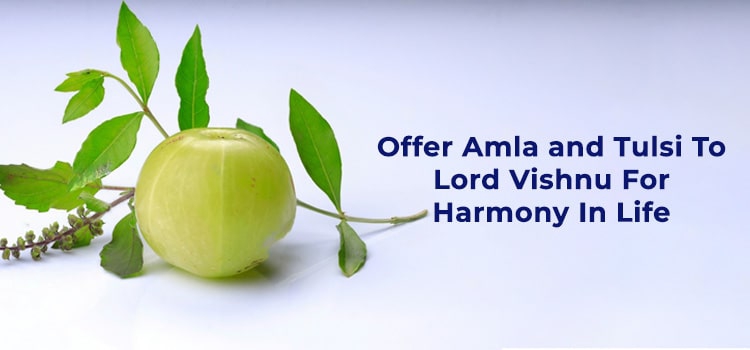Offer Amla and Tulsi To Lord Vishnu For Harmony In Life
Hindus often offer Amla (Indian gooseberry) and Tulsi (holy Basil) to Vishnu to please him and seek his blessings. Both are sacred symbols in Hinduism and are used in rituals and ceremonies. Both have medicinal uses as well.
Offering them to Lord Vishnu can supposedly bestow good health. Amla is good for the skin, eyes, and hair, and Tulsi has anti-bacterial, anti-viral, and anti-inflammatory properties.
As Vishnu is the deity of wealth and prosperity, offering Amla and Tulsi to him can bring financial abundance. Amla signifies wealth and prosperity, while Tulsi signifies luck. Offering Amla and Tulsi to Vishnu can also purify our souls. They bring spiritual purity.
Vishnu is also the deity of peace and harmony, and offering him Amla and Tulsi can bestow peace and harmony on the devotees. Both plants have the power to calm the mind and foster peace.

Amla Tree in Hinduism
Amla/Dhatri/Dhatrika means 'nourishing mother'. The tree is much-revered as it is associated with both Lord Vishnu and Siva.
Amla is supposedly the first tree to have appeared on earth, so people call it the Adiroha or pre-eminent tree. Even the act of remembering the tree confers many virtues and earns the merit of donating a cow, goes the belief. Performing Pind daan under this tree can bestow salvation on deceased ancestors. Also, eating amla fruits supposedly bestows 3 times the merit of donating a cow. The final gift to the Buddhist sangha by Emperor Ashoka was half an amalaka fruit. King Athiyaman gifted Avvaiyar, a Tamil poet and saint of the Sangam age, an amla fruit for long life.
According to the Hindu Panchang, there are 24 Ekadashis in a year. Each Ekadashi has its own importance and bestows boons on the devotees who observe fast or Vrat.. As per the Bhagavata Purana, one who observes Ekadashi fast can attain the Vaikunth (Vishnu’s abode).
Amalaki Ekadashi is very special, among all the Ekadashis. Vaishnavites worship Vishnu under the Amla tree on this day. Skanda Purana claims that Vishnu resides in the Amla tree. During Karthik month (Oct-Nov), devotees perform a marriage ceremony between the Tulsi plant and the Amla tree, as devotees believe that they are Goddess Lakshmi and Vishnu, respectively. This is Tulsi Vivah (meaning Tulsi’s marriage). During the marriage ceremony, devotees keep a stem of the Amla tree next to the Tulasi plant and worship them.
Once during the great flood or Maha Praalaya, Brahma performed penance to please Vishnu. Vishnu appeared before him, and on seeing this, happy tears flowed from Brahma’s eyes. They fell on earth and became Amla trees, says a Puranic legend. Vishnu promised Brahma that he would reside in the Amla tree and bestow boons to those who worship him on Amalaki Ekadashi.
Tulsi in Hinduism
In Hinduism, the Tulsi plant, or Basil, is the holiest of all plants. Devotees see it as a threshold between heaven and earth. According to a traditional Hindu prayer, Brahma dwells in its branches, all the Hindu pilgrimage centers reside in its roots, the holy Ganges river flows within its roots, all the deities dwell in its stem and its leaves, and the Vedas, the most sacred Hindu texts, are found in the upper part of the plant’s branches. Mostly, women worship the Tulsi, so it is called the "women's deity." It symbolizes wifehood and motherhood. To Vishnu devotees, it represents the manifestation of god in the world of plants.
One who waters and cares for the Tulsi daily can gain spiritual merit and the divine grace of Vishnu, even if one does not worship it. Women are responsible for the daily worship and care of the plant. Tuesdays and Fridays are very sacred for Tulsi worship. The worship rituals include watering the plant, cleaning the area near the Tulsi plant with water and cow dung, and offering food, flowers, incense, Ganges water, etc. Women also draw kolams or Rangolis designs of deities and saints near its foot. They pray to the plant and go around it while chanting Mantras. Tulsi worship usually takes place twice a day (morning and evening), and a lamp or candle is lit near the plant during the worship.
Tulasi is very important in the worship of Vishnu and his forms, Krishna and Vithoba, as well as other Vaishnava deities. Devotees offer garlands made using 10000 Tulsi leaves, food items sprinkled with Tulsi, water mixed with Tulsi etc., to Vishnu or Krishna.
They also use japa malas (rosary) made from Tulsi stems or roots. These Tulsi malas are beneficial for the person who wears them. They can supposedly help the wearer to connect with Vishnu or Krishna and gain his protection.
Legends behind Tulsi
There are many legends about the Tulsi plant in the various Puranas. The Skanda Purana, Padma Purana, and Shiva Purana tell the story of Tulsi.
Vrinda was a pious woman and an ardent devotee of Vishnu. She was the daughter of Kalanemi, an asura. Her husband was Jalandhara, an asura who was born from Shiva's rage. After the Samudra Manthan, the gods drank the Amrit without sharing it with the Asuras. This angered Jalandhara. He waged war against the gods and conquered heaven. He proved to be a good ruler. But after hearing from Narada how beautiful Goddess Parvati was, he ordered Shiva to hand her over to him.
A furious Shiva declared war on the Asura but could not defeat him. The Asura used his illusory arts to kidnap Parvati after assuming the form of Shiva. Parvati prayed to Vishnu, who realized that the Asura was immune to defeat due to the chastity of his wife.
Vrinda, meanwhile, had a nightmare in which she saw Jalandhara sitting on a buffalo, the sky dark and ominous, and a sun that lacked its usual brilliance. Terrified of the dream’s portents, she ran wild, forgetting herself. A sage rescued her from two rakshasas, and she asked him for tidings of her husband's battle with Shiva. The sage's disciples showed her the hands, head, and headless trunk of the Asura. The heartbroken Vrinda begged the sage to revive her dead husband, which he did. Thinking it was actually her husband, Vrinda lived with him for several days until she discovered his true identity.
Devastated, she cursed Vishnu, saying that he would be separated from his wife, too. This happened when Ravana kidnapped Sita during Vishnu’s Rama avatar. Then she immolated herself, though Vishnu tried to stop her. As Vrinda had lost her chastity, Shiva defeated Jalandhara.
Vishnu was traumatized by the death of Vrinda and refused to leave her pyre. The gods invoked Prakriti, the personified force of nature. Prakriti offered them three seeds to be planted at the spot where Vishnu stayed. They represented the sattva, rajas, and tamas gunas. The seeds became three plants, Dhatri, Malati, and Tulasi, which turned into three women, Svarā, Lakṣhmī, and Gaurī. Vishnu was smitten by the sight of the beautiful women. But Mālatī was seen as "deceptive" (as she came from Lakṣmī, who was already Vishnu's shakti), and hence, she is condemned. Dhātrī and Tulasī, however, have a genuine love for Vishnu and help him to forget his sorrow. They accompanied Vishnu to Vaikuntha, and he was very pleased with them.
Another version of this legend says that Vrinda immolated herself in her husband's funeral pyre. But Vishnu made her incarnate as the Tulsi plant on the earth. She also gets the status of a goddess named Tulasi.
A Vaishnava legend claims that, at the end of Samudra Manthan, Dhanvantari emerged from the ocean with Amrit (the elixir of immortality). Vishnu served it to the gods and shed happy tears. The first tear fell in the Amrit and formed the Tulsi.



















